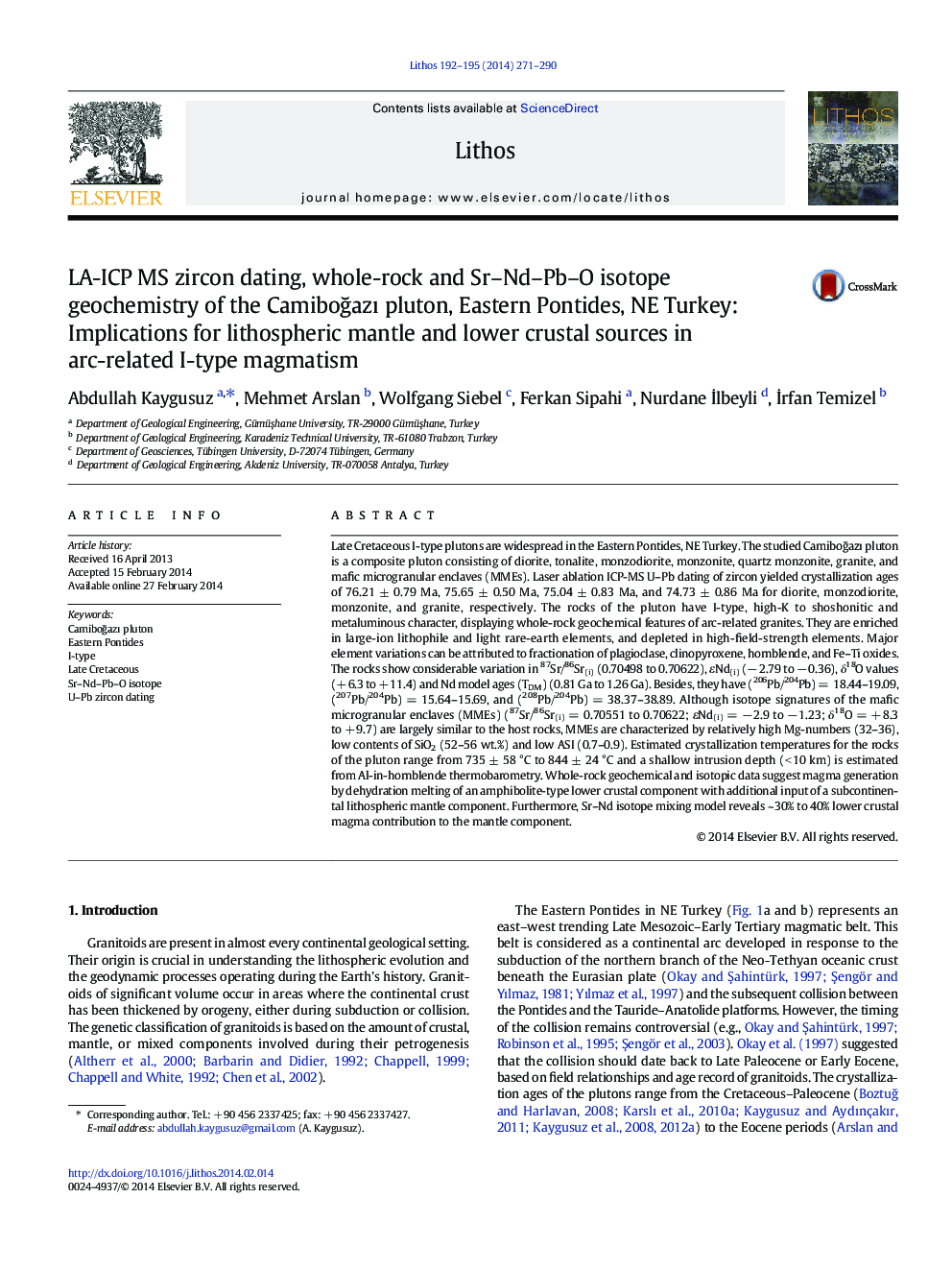| کد مقاله | کد نشریه | سال انتشار | مقاله انگلیسی | نسخه تمام متن |
|---|---|---|---|---|
| 4716056 | 1638679 | 2014 | 20 صفحه PDF | دانلود رایگان |

• Late Cretaceous I-type plutons are widespread in the Eastern Pontides.
• We report new geochemical, Sr–Nd–Pb–O isotopic and LA-ICP MS U–Pb zircon data.
• Late Cretaceous Camiboğazı pluton was emplaced at shallow depths.
• Late Cretaceous Camiboğazı pluton displays high-K to shoshonitic character.
• The pluton originated by mixing of lower crustal and mantle-derived end-members.
Late Cretaceous I-type plutons are widespread in the Eastern Pontides, NE Turkey. The studied Camiboğazı pluton is a composite pluton consisting of diorite, tonalite, monzodiorite, monzonite, quartz monzonite, granite, and mafic microgranular enclaves (MMEs). Laser ablation ICP-MS U–Pb dating of zircon yielded crystallization ages of 76.21 ± 0.79 Ma, 75.65 ± 0.50 Ma, 75.04 ± 0.83 Ma, and 74.73 ± 0.86 Ma for diorite, monzodiorite, monzonite, and granite, respectively. The rocks of the pluton have I-type, high-K to shoshonitic and metaluminous character, displaying whole-rock geochemical features of arc-related granites. They are enriched in large-ion lithophile and light rare-earth elements, and depleted in high-field-strength elements. Major element variations can be attributed to fractionation of plagioclase, clinopyroxene, hornblende, and Fe–Ti oxides. The rocks show considerable variation in 87Sr/86Sr(i) (0.70498 to 0.70622), εNd(i) (− 2.79 to − 0.36), δ18O values (+ 6.3 to + 11.4) and Nd model ages (TDM) (0.81 Ga to 1.26 Ga). Besides, they have (206Pb/204Pb) = 18.44–19.09, (207Pb/204Pb) = 15.64–15.69, and (208Pb/204Pb) = 38.37–38.89. Although isotope signatures of the mafic microgranular enclaves (MMEs) (87Sr/86Sr(i) = 0.70551 to 0.70622; εNd(i) = − 2.9 to − 1.23; δ18O = + 8.3 to + 9.7) are largely similar to the host rocks, MMEs are characterized by relatively high Mg-numbers (32–36), low contents of SiO2 (52–56 wt.%) and low ASI (0.7–0.9). Estimated crystallization temperatures for the rocks of the pluton range from 735 ± 58 °C to 844 ± 24 °C and a shallow intrusion depth (< 10 km) is estimated from Al-in-hornblende thermobarometry. Whole-rock geochemical and isotopic data suggest magma generation by dehydration melting of an amphibolite-type lower crustal component with additional input of a subcontinental lithospheric mantle component. Furthermore, Sr–Nd isotope mixing model reveals ~ 30% to 40% lower crustal magma contribution to the mantle component.
Journal: Lithos - Volumes 192–195, April 2014, Pages 271–290